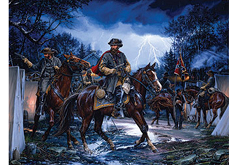The War Between the States offers a stirring narrative of America's greatest epic and worst tragedy. The U.S. Civil War was in reality a fifty year war (1828-1877) and the authors present its story, beginning with the many reasons for the conflict, the major events and personalities that shaped it, and the issues resolved and unresolved by it. What sets the book apart from virtually any other modern narrative of the subject are the lenses through which it is written—the traditional principles of American Constitutionalism and a Biblically-based, Christian world view. It is designed to provide home school and private school students with a comprehensive, historically accurate, and artistically attractive account of the war, its causes, and its aftermath and implications for later generations.
Since The War Between the States focuses on a smaller period of history than typical history textbooks, it can take the time to really flesh out the causes of the war, describe the war itself, and help us to understand what the effects of the war actually were. The book is designed to do just that, and it is broken up into three sections with a total of thirty-eight chapters.
-
Part I: Causes of War takes eleven chapters to explain the historical background of nationalism vs. regionalism, define secession and clarify the issue of state rights, describe the tariff that was a major cause for frustration in the south, discuss the slavery question, and depict the religion and worldview of Americans of that time. There are nearly 200 pages on causes alone!
-
Part II: The War is comprised of nineteen chapters which illustrate the flow of the war in both the East and the West. Significant attention is paid to acts and undertakings that present clearly moral dimensions, both good and evil. These include atrocities and clearly unbiblical deeds, but also acts of Christian charity and the expansion of the Church during the midst of war.
-
Part III: Post-War and Reconstruction uses the last eight chapters to describe the "peace" that followed the war, and also discusses the 13th-15th Amendments, the rise of vigilante groups such as the Ku Klux Klan, the struggles of free American blacks, the South's attempt to recover from devastation, and much more. The years just following the War are some of the most dramatic and pivotal in American history, but they are often overlooked and misunderstood. If they are not ignored, they are usually explored through a politically correct, even Marxist, lens. This text refuses to take that approach, offering instead a balanced, yet Biblical perspective.

And the book looks great! In its nearly 700 pages, it offers more than 530 illustrations, including 30 paintings by acclaimed artist John Paul Strain. Also incorporated throughout the text are historical sidebars and maps, and nearly 100 biographical sketches.
Since the book provides such a feast of information and illustrations for the general reader outside the classroom, the publisher avoided adding ancillary material that would normally appear in a textbook, such as study questions, key terms, and recommended resources. All of these things, along with quizzes, tests, lesson plans, chapter summaries, and suggested projects and activities are being created and made available for free in an online study guide.
Did you find this review helpful?